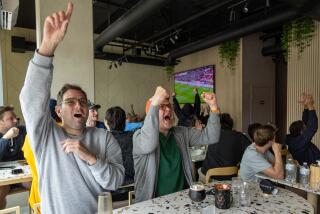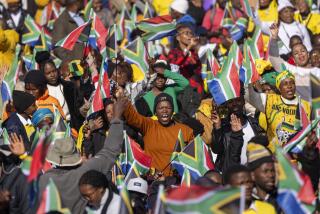Soccer City workers are also building a new nation
- Share via
JOHANNESBURG -- Over a decade later, Ntombie Khofane still feels the warmth of Nelson Mandela’s handshake and remembers his message to students at her school that life can get better.
Boosted by her belief that he was right, Khofane left her unemployment-riddled Mount Ayliff area six years ago and took a bumpy, nine-hour bus ride into Soweto.
Now, she has already made it up to assistant surveyor at the Soccer City Stadium, living proof of how construction for the World Cup is building more than mere sports arenas.
Such projects are offering jobs and a sign of how far the nation has progressed since the dark days of apartheid.
The 94,000-seat Soccer City Stadium, which will host the World Cup final, has risen like a huge cooking pot from the red dust, framed by slag heaps from gold mining on one side and Johannesburg skyscrapers on the other.
In all, six new stadiums are being built for next year’s World Cup, but none is bigger than the one where Khofane works.
And amid the hustle of some 3,500 workers trying to get it ready, she finds herself ever more at home surrounded by workers of many colors.
“Now, there is no difference between black and white,” Khofane said. “We work together, and that makes me happy.”
As workers dangle from long ropes hanging from the roof and others rush through the dust from sanding the concrete ramps, there is a genteel civility among all where once a color-coded hierarchy reigned.
And while construction sites around the globe are often dominated by men, South African women make up about 30 percent of jobs at the Soccer City Stadium.
As assistant surveyor, Khofane measures and checks designs on the western side of the stadium, everything from offices to toilets.
At 30, it is the right place when you aspire to become a foreman.
“This job is making me more than clever,” she said, grinning.
Even in her current position Khofane provides an example of the giant strides South Africa has made.
Under apartheid, most blacks were denied proper education and job opportunities, pushing them deeper into poverty.
Their living conditions were often desperate while whites enjoyed near Western living standards.
It is that legacy that people such as Khofane now try to overcome.
Her region of Mount Ayliff is in an almost exclusively black area where, when she was growing up, 75 percent of the families made less than $125 a month and three quarters of the active population was unemployed.
Little wonder a single word defines why she came to Johannesburg: “money.”
Her desire for work and a better life was stronger than the fear she had leaving five brothers and a sister behind.
She moved on a hunch because “a neighbor knew someone in Soweto.”
She started out sewing jeans, at $35 for two weeks work.
“It was bad pay,” she said.
The construction industry, however, looked promising despite its heavy physical demands.
From there she got a job helping to build the $86 million Maponya Mall in the heart of Soweto, the crowded township where black workers were forced to live during the apartheid years.
Financed by a self-made black entrepreneur, it was opened two years ago and is a symbol of civic pride, allowing blacks to spend and shop where they live.
“I am proud I worked there,” she said. “It is very important to me.”
Even though things are looking up for Khofane, the gap between rich and poor has not narrowed since Mandela became South Africa’s first black president in 1994, with only a small number of blacks joining the whites on the affluent side of the divide.
The key to the future, though, is to increase the overall standard of living.
That is why the World Cup and projects like the Maponya Mall mean so much, allowing funds to trickle through to ordinary blacks.
A surveyor like Khofane can now make about $600 a month.
Louis Dubazana, one step ahead of Khofane as a section leader, also worked on the mall.
He says he is just as much infused with the drive to carve out something for himself in this new age of equality.
He has a wife and two preteens in Amersfoort, Mpumalanga, which is about 60 miles away.
To be close to his work at Soccer City now, he lives on the edge of Soweto in Dobsonville and only sees his family once a month for two days.
He has vivid memories of seeing a Mandela rally on television and fully realizes what it has meant for a kid who grew up with segregation and lack of opportunity as a given.
“All this could not have happened without him,” he said.
“This,” Dubazana said, “is like a dream for us to reunite all the people in South Africa.”







